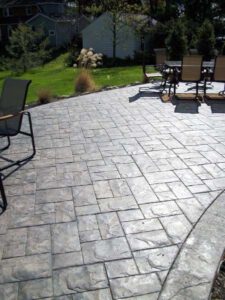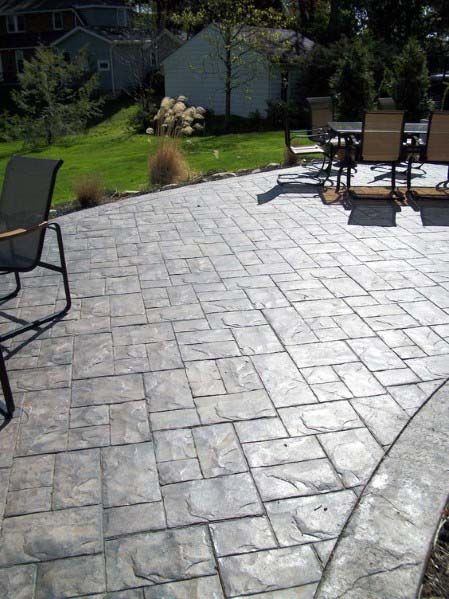Stamped concrete is a versatile material that can mimic the appearance of fractured earth, real stone, or even wood. It’s also typically less expensive than other materials.
The contractor stamps the concrete shortly after it’s poured using flexible polyurethane molds. These are applied with a color release agent, which acts as a nonstick surface to prevent the stamps from sticking to the wet cement. For concrete services needs, contact the experts at Level Ground Excavation.
If you’re thinking about using stamped concrete for your next project, you might be wondering how much it will cost. Fortunately, there are some ways to keep costs down while still getting the look you want. For starters, it’s important to consult with a professional. Doing so will ensure that your project is completed correctly and that you get the best possible results. It’s also a good idea to book your contractor several months in advance so you can avoid rush prices. Finally, make sure to seal the concrete after it’s complete to protect against moisture and stains.
The price of a stamped concrete project can vary depending on the size and complexity of the job. For example, a smaller patio with fewer patterns may be less expensive than a larger driveway with more elaborate designs. In addition, the concrete type and color can impact the cost. Typically, colored concrete is cheaper than plain gray concrete.
Another factor that can affect the cost of a stamped concrete project is whether or not it requires reinforcements. Adding reinforcements like mesh or a vapor barrier can increase the strength of the slab, which in turn will extend its lifespan. However, this adds to the overall cost of the project.
One of the biggest benefits of stamped concrete is that it’s very affordable compared to natural stone, brick, or pavers. It’s also a lot more convenient to install than traditional poured concrete. And it’s incredibly versatile, as you can choose from a wide variety of textures and colors.
During the installation process, it’s important to carefully align the edges of each stamping skin. This will help to ensure that the finished result is consistent and eye-catching. The concrete must also be properly dried in order to prevent cracking and crumbling. To do this, workers can use a color release agent or a deicing product to slow down the water evaporation rate.
After the concrete has been poured and stamped, it must be cured and sealed. A quality sealer can help preserve the color and sheen of the concrete and prolong its life. However, it’s important to note that any sealer has a limited life span and will eventually need to be resealed. Your contractor should be able to recommend the right products for your project.
Durability
Stamped concrete is a versatile material that can mimic the look of natural stone, brick, or wood at a fraction of the cost. It is also a durable surface that can withstand heavy foot traffic and weather extremes. However, like any surface, it must be properly maintained to ensure longevity and prevent deterioration.
To get the best results from stamped concrete, it is important to choose a professional contractor who has experience working with decorative concrete. They will understand how to mix the concrete correctly, use the right tools and techniques, and prep the concrete for stamping or textured skin application. McEntee Construction has years of experience in concrete installation, and their experts can ensure your project is completed correctly.
It is important to note that the durability of stamped concrete depends on how it is installed and what kind of foot traffic it will receive. If it is not installed correctly, it may crack or break more easily than traditional poured concrete. It is also a good idea to limit the amount of substantial weight that will be placed on the concrete, as this can cause it to crack more quickly.
Before you start the concrete stamping process, it is important to apply a release agent. This will help keep the rubber stamps from sticking to the concrete and disrupting the imprint texture. Release agents come in both powdered and liquid forms and should be applied to the stamps before they are placed on the concrete.
When applying the stamps, it is important to press down evenly and firmly. If the pressure is uneven, it will cause an unsatisfactory pattern, and the concrete may not dry completely. It is also important to keep an eye on the weather, as sun and shade exposure can affect drying time. The concrete should be stamped and textured at the best possible time for the best results.
Once the concrete is cured, it must be sealed to protect it from stains and UV rays. It is also important to periodically inspect the concrete for any signs of wear and tear, as cracks can sometimes become worse over time. If you notice any cracks, it is a good idea to have them repaired by a professional as soon as possible to prevent further damage.
Aesthetics
Concrete is one of the most commonly used building materials in the world, and it’s well known for its affordability and durability. But what many people don’t know is that concrete can also be manipulated to achieve a wide range of aesthetics, making it an extremely versatile material for everything from sidewalks and parking garages to home patios and basement floors.
Aesthetically, it can mimic the look of stone, brick, flagstone, and wood. Contractors use special stamping mats to create a specific texture on the surface of fresh concrete, and coloring mediums are often added to achieve natural-looking color variations, just as they would be in real stone or other materials. From rustic and country to elegant and sophisticated, the options for stamped concrete are virtually limitless.
Unlike paving stones and slabs, which have to be ordered in advance and delivered to the site pre-cast, stamped concrete is made on-site, meaning it can be customized to fit the exact dimensions of the space in question. This gives contractors greater flexibility when designing a particular layout, and it allows homeowners to match their concrete with existing stone, tile, or textured concrete elements in the surrounding landscape or architectural design.
As with any surfacing material, it is possible for cracks to develop in the concrete over time. However, if the concrete is installed properly to begin with, these cracks will be hard to detect and will usually blend in with the pattern and joint lines. Moreover, most contractors offer methods for concealing these cracks in order to ensure that the finished product is as visually appealing as possible.
Another advantage of stamped concrete over paving stones and slabs is that it typically requires less maintenance. Unlike pavers and slabs, which need to be individually removed and replaced when they are damaged or worn down, concrete can usually be repaired by resealing. Additionally, concrete doesn’t fade as easily as other materials, and resealing it will help keep it looking its best.
Maintenance
The maintenance of a stamped concrete surface depends on many factors. The best way to maintain stamped concrete is to clean it regularly with a non-abrasive, mild cleaner, such as soap, detergent, or dishwashing liquid. The use of these products will prevent the buildup of everyday dirt and grime, which can cause permanent stains and damage the decorative elements in the concrete. If the concrete requires a more rigorous cleaning, it can be scrubbed with a broom or power washer. Regardless of the type of cleaning, the concrete should be rinsed thoroughly afterward to avoid damaging the sealer.
Proper curing of the concrete is another important factor in maintaining a beautiful stamped concrete surface. The curing process takes time, but it will help prevent future cracking and make the concrete stronger. It is also a good idea to cut contraction joints (also known as control joints) into the concrete. This will help reduce the stress caused by temperature changes and drying shrinkage.
A properly designed and executed stamped concrete project is a great investment that will add value to your home. However, it is important to understand that no concrete installation is permanent. The appearance of the concrete will fade over time, and it may need to be resealed. When this happens, the concrete will not look as vibrant and appealing as it did when it was first sealed.
It is a good idea to reseal the concrete every two years, or as needed. Resealing will prevent the concrete from becoming brittle and damaged by the sun, wind, and rain. It will also prevent the color from fading.
If the concrete is heavily used, it should be resealed sooner. You can also use an anti-skid additive to help improve traction on the surface. Another thing to remember is not to let pets relieve themselves on the concrete. Their urine is very acidic and will damage the surface over time.
It is also a good idea to keep the driveway clear of ice and snow. Freezing and thawing can cause the ice to expand, which can damage the stamped patterns and create cracks. It is best to sweep the driveway and use a plastic shovel instead of a metal one to avoid scratching or chipping the concrete. Deicing chemicals should be avoided as well, as they can eat away at the sealer and damage the concrete.
